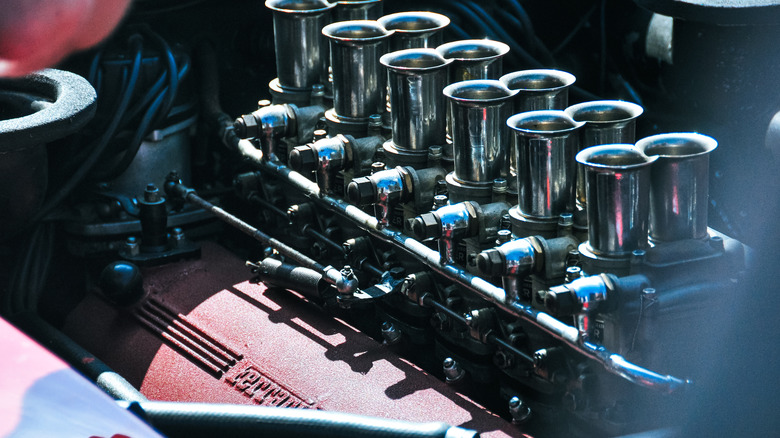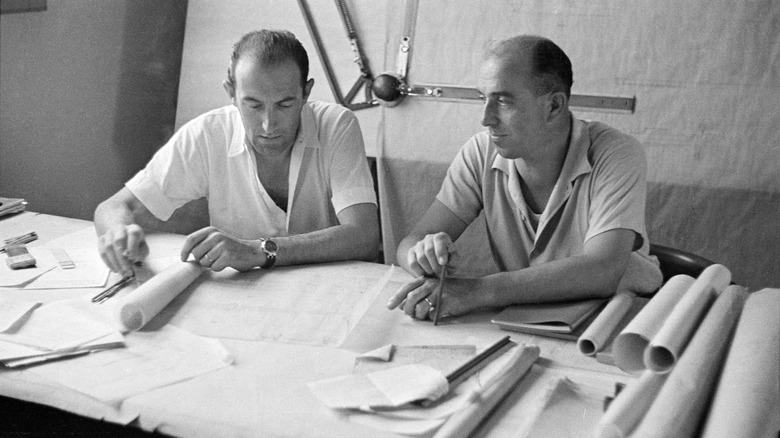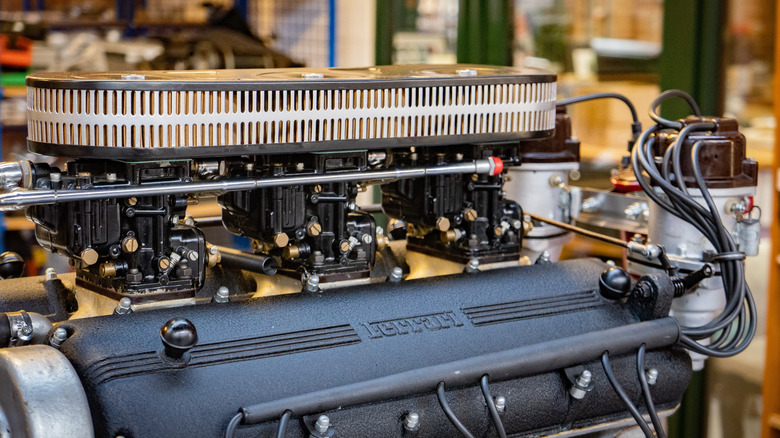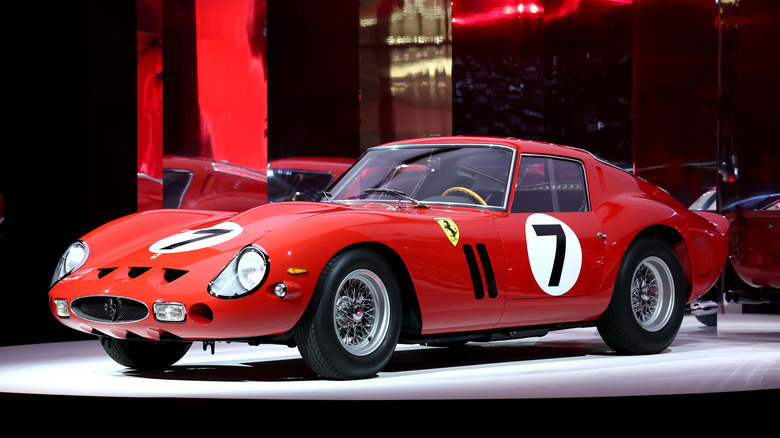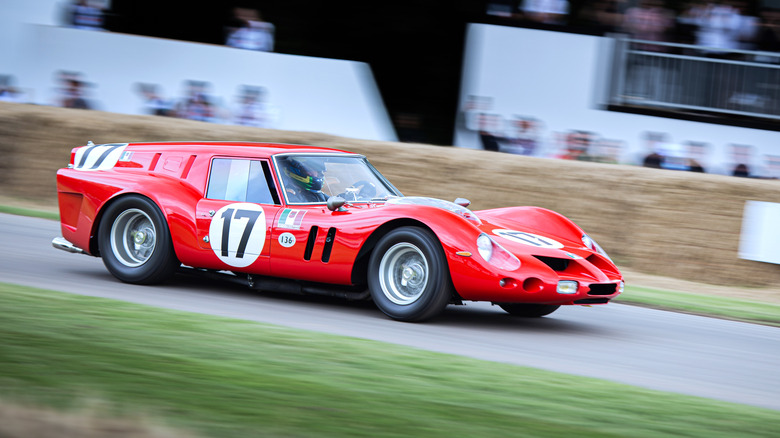Here's What Made Ferrari's Colombo Engine So Special
Enzo Ferrari's reluctance to speak English makes it difficult to determine the authenticity of some of his most admired quotes, but perhaps the most famous is this: "When you buy a Ferrari, you are paying for the engine. The rest you get for free." Urban legend it might well be, but a glance at a Ferrari V12 engine from any era — or, equally evocative, a chance to hear the music it creates — is more than enough to make one believe Enzo said exactly that.
And it would have been said with little hyperbole. Born in 1947, the Ferrari V12 is one of the all-time great engines. The core architecture of the first generation — called the Colombo, after Italian engineer Gioacchino Colombo — wasn't fully replaced until the 1990s. Even today, Ferrari still applies a wrinkled red finish to the rocker covers of its V12s, a design detail established by the Colombo-engined 250 Testa Rossa (Italian for "redhead") in 1957.
Who was Gioacchino Colombo?
Before focusing on the engine, it's worth understanding the man behind the machine. Born in Milan in 1903, Gioacchino Colombo (above, right) was an Italian engine designer whose resume boasted work at Alfa Romeo, Maserati, Bugatti, MV Agusta, and Ferrari.
Colombo joined Alfa Romeo at age 21 and worked on the P2 Grand Prix race car. By 1928 (aged just 25), he was promoted to head of the technical department, overseeing both Alfa Romeo's road and race cars. In 1937, he left Alfa to join Ferrari, where he began work on the company's early V12 engines, but returned to Alfa just a year later as head of the race team's design department. In that role, Colombo saw his 1.5-liter, supercharged V12 engines win their first races and enjoy a successful few years before the competition was suspended during World War II.
As well as a small capacity and 12 cylinders, these early Colombo engines were known for their light weight. They featured a block cast from a type of magnesium called Elektron instead of the iron used by other manufacturers, and the case was made from two separate castings integrated with a shared head with dual overhead camshafts and a chrome nickel-plated crankshaft.
Colombo rejoined Ferrari in 1945 and was tasked with designing a 1.5-liter V12 engine for use in road cars as well as Enzo's beloved racers. Colombo agreed with Mr. Ferrari that the small-capacity V12 should have a single camshaft for each bank of six cylinders.
What was special about the Colombo V12?
All V12s are special, thanks to how the firing order of their 12 cylinders delivers power that "feels more like a continuous twist than discrete pulses," as Hagerty neatly explains. Downsides of V12 engines include their inherent size, cost, and weight compared to motors with fewer cylinders, which is why the layout generally only appears in luxury cars and highly-strung racers.
Apart from its beautiful balance, Colombo's V12 stood out thanks to its aluminum block and head castings, bringing strength and reliability. Other highlights included a cast aluminum oil sump with ribs to radiate heat, a crankshaft machined from a single billet of alloy steel, and forged steel connecting rods.
The Colombo V12 also had an over-square bore/stroke ratio, with a short stroke decreasing the reciprocating motion of the pistons, lowering the height of the block and thus the center of gravity of the engine and car, improving handling. An unusually large bore made for bigger valves and increased volumetric efficiency, while Colombo's use of hairpin springs instead of spiral-wound coil springs made the engine less susceptible to fatigue failure. The springs also improved air cooling and allowed for shorter, lighter valve stems.
Lastly, 90mm cylinder bore spacing made the engine compact while still allowing plenty of room to accommodate an eventual doubling of the capacity. By the end of production, the Colombo V12 would swell from its original 1.5 liters and 100 horsepower to 4.9 liters and 395 horsepower.
Which cars used the Colombo V12?
Colombo's engine quickly grew to 2.0 liters for the 1948 season, in which guise it powered a Ferrari 166 Barchetta to victory at the Giro di Sicilia and the Mille Miglia. Breathing through three Weber 32 DC carburettors, the latest incarnation produced 142 horsepower.
Often described as jewel-like, Colombo's engine is estimated to have required up to 70% longer machining time and 50% more parts compared to an in-line, six-cylinder engine, according to The Road Rat magazine. Despite this, the motors were built in a workshop described in 1957 by Autosport journalist Graham Gauld as a place where "the various parts and components were assembled without respecting a given sequence." Gauld branded the production line as "chaos organized."
Despite their handmade charm, these engines went into some of the greatest cars to ever emerge from Ferrari's Maranello factory. These include the 250 Testa Rossa of 1957, named after the engine cam covers painted wrinkled red; the impossibly beautiful 250 GT California Spider from 1957; the iconic 250 GT SWB two years later; and the most valuable Ferrari of all time, the 250 GTO.
The Colombo also powered the mid-engined 250 LM, followed by the greatest-hit Ferraris road cars like the 400 Superfast, 275 GTB, and 365 GTB/4 Daytona. The final iteration appeared in the 412 four-seater of 1985. Production ran for four years until both the 412 and its Colombo engine were retired shortly after Enzo's death in August 1988.
A sound like no other
The Colombo V12 is praised for its balance, toughness, and longevity, but it's the sound that keeps Ferrari fans awake at night. I'm fortunate to have driven several Colombo-engined Ferraris, including a 250 Lusso, 250 SWB, and 330 GTC.
All three cars deliver a unique driving experience and soundtrack, but I remember the race-bred SWB most fondly. Although surprisingly usable at low speed, its V12 constantly feels as if it is egging the driver on, begging them to drop a couple of gears, blip the throttle, and accelerate hard to the red line.
Do this, let the rev indicator sweep well beyond five thousand, and the Colombo V12 transcends engineering. It delivers plenty of power, but the sound erupting from the quartet of polished tailpipes is what really matters. What begins as an omnipresent roar quickly shifts into a full-bodied wail. Delicate, complicated, and multifaceted, yet unashamedly loud, it's the sound of an entire orchestra reaching a crescendo in perfect harmony, seemingly conducted by Colombo himself.
Switch to the calmer, quieter, comfier, and more luxurious Lusso, and its closely related V12 has a relaxed demeanor. It'll still sing beautifully when called upon, but there's less frenzy. Experience these cars back-to-back, and Colombo's magic is clear to see. This is an engine with a broad skill set and the ability to leave itself forever etched into the driver's memory. It is one of the all-time greats.
